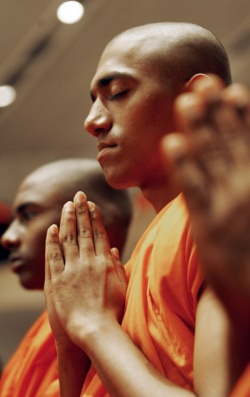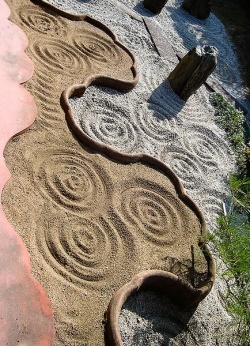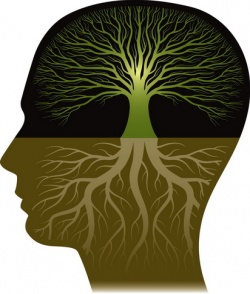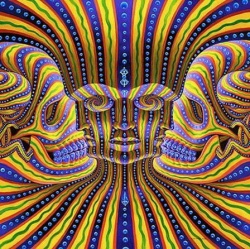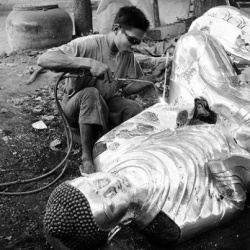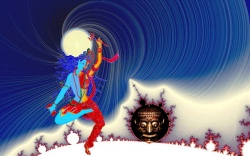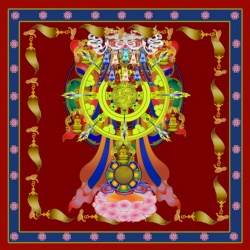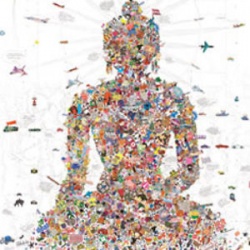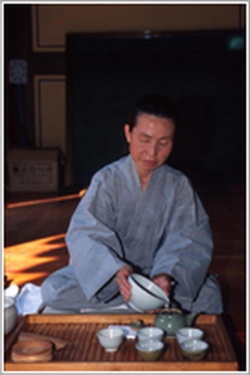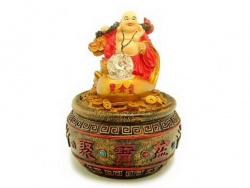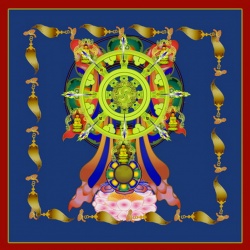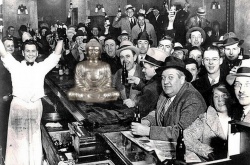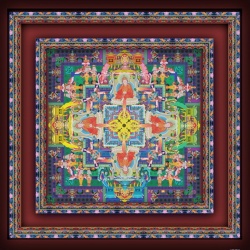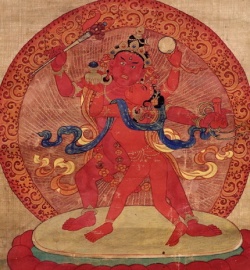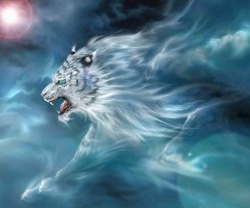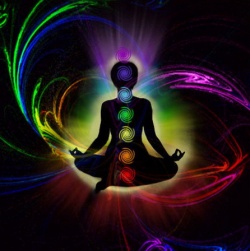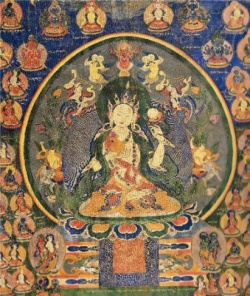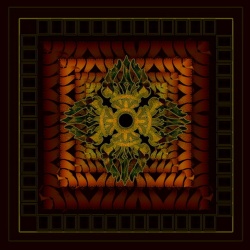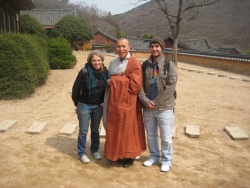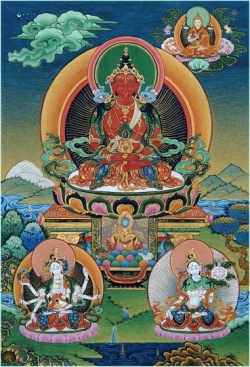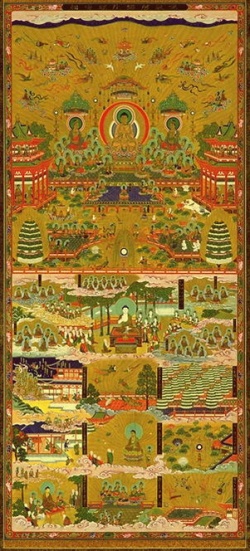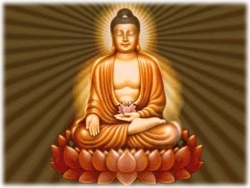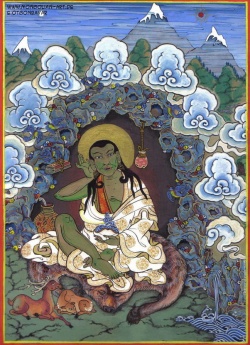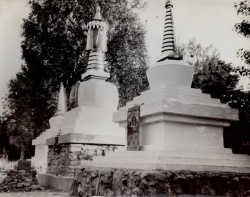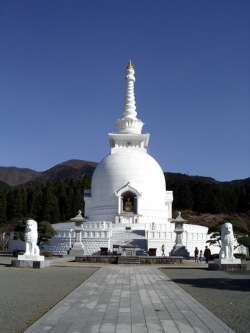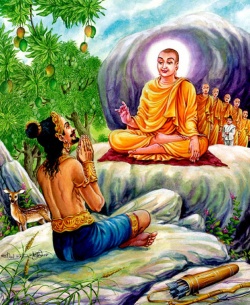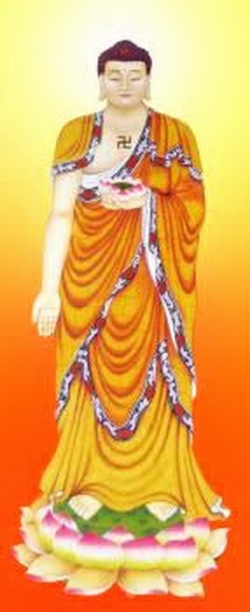Experience, Realization, View, Practice and Fruition
by: Wei Yu
I was trained in these 3 aspects and Thusness asked me to write something clearer about 'experience, realization and view' and synchronistically I actually had the same thought on that day. I think I'm going to add this as one of those preface chapters before I start with the journal section in my e-book.
So the 3 aspects I'm talking about are:
1. The Experience
2. The Realization
3. The Implications of View
However, for the sake of this article and benefit for readers, I will add two more:
4. The Practice
5. The Result/Fruition
I put Practice after the first three instead of dealing with practice in the first part because I want people to know what they are doing their practice for, and the reason why they are doing those practices, how those practices result in realization and their effects on View. You will understand as you read further.
This article documents my insight and experience and journey. Even though whatever I said is authentic, spoken from experience, accurate, it is not meant to be an authoritative map for everyone - not everyone goes through these insights in the same linear fashion (the Buddha only taught people to realize Anatta and Shunyata in the traditional Pali texts and did not talk about Self-Inquiry or I AM/Self-Realization, even though the luminous mind is spoken of, for instance), however it is true that all traditions of Buddhism (provided that there is right guidance and training) will eventually result in these various kinds of insights and experience, despite going through a different path or practice.
It should also be understood that when people talk about "no-self", it could imply a number of things... from impersonality, to non-dual, to anatta. In worse case it is being misunderstood as dissociation (I, the observer, dissociates from phenomena as not myself). Therefore, we should always understand the context of 'no self' that is being said by the practitioner or person and not always assume that the 'no self' must be the same as the 'no self' you have in mind. Due to lack of clarity, very often 'anatta' is confused with 'impersonality', or 'anatta' with 'non-duality'. They are not the same even if there may be overlaps or aspects of each in one's experience. One must be careful to distinguish them and not confuse one with another.
I would also like to quote from Thusness a forum post made in 2010 which I feel is quite important to understand, "...there exist a predictable relationship between the 'mental object to be de-constructed' and 'the experiences and realizations'... As a general guideline,
1. If you de-construct the subjective pole, you will be led to the experience of No-Mind.
2. If you de-construct the objective pole, you will be led to the experience of One-Mind.
3. If you go through a process of de-constructing prepositional phrases like "in/out" "inside/outside" "into/onto," "within/without" "here/there", you will dissolve the illusionary nature of locality and time.
4. If you simply go through the process of self-enquiry by disassociation and elimination without clearly understanding the non-inherent and dependent originated nature of phenomena, you will be led to the experience of “I AMness”.
Lastly, not to talk too much about self-liberation or the natural state, it can sound extremely misleading... …we have to understand that to even come to this realization of the “Simplicity of What Is”, a practitioner will need to undergo a painstaking process of de-constructing the mental constructs. We must be deeply aware of the ‘blinding spell’ in order to understand consciousness…"
I will now start explaining 'experience'. There are a number of important experiences related to our true nature:
1. Pure Presence/Witness
This is the case when practitioners have experienced a pure radiance of presence, awareness, in the gap between two thoughts. Having recognised this pure presence-awareness, one tries to sustain this recognition in daily life. In daily life, one may sense this as a background witnessing presence, a space-like awareness in the background of things. It is felt to be something stable and unchanging though we often lose sight of it due to fixation on the contents of experience or thoughts (like focusing on the drawing and losing sight of the canvas). This is related to the 'I AM', but still, this is the experience, not the realization.
2. Impersonality
This is the case when practitioners experienced that everything is an expression of a universal cosmic intelligence. There is therefore no sense of a personal doer... rather, it feels like I and everything is being lived by a higher power, being expressed by a higher cosmic intelligence. But this is still dualistic – there is still this sense of separation between a 'cosmic intelligence' and the 'world of experience', so it is still dualistic.
I experienced impersonality after the I AM realization, however some people experience it before I AM realization. Theistic Christians may not have I AM realization (it depends), however through their surrendering to Christ, they can drop their sense of personal doership and experience the sense of 'being lived by Christ', as in Galatians 2:20: "I have been crucified with Christ and I no longer live, but Christ lives in me.". This is an experience of impersonality that may or may not come with the realization of I AM.
3. Non-dual into One Mind.
Where subject and object division collapsed into a single seamless experience of one Naked Awareness. There is a difference between a temporary non-dual experience and non-dual insight. Explained later.
4. No-Mind
Where even the naked Awareness is totally forgotten and dissolved into simply scenery, sound, arising thoughts and passing scent. This is the experience of Anatta, but not the realization of Anatta. Explained later.
5. Sunyata (Emptiness)
It is when the 'self' is completely transcended into dependently originated activity. The play of dharma. There is a difference between this as a peak experience and the realization of emptiness/dependent origination. Explained later.
Next is the 'Realization':
1. The Realization of I AM
Having an experience of witnessing, or a state of pure presence, is not the same as having attained the doubtless self-realization - in that case the practitioner can be said to have an experience, but not insight/realization. I have had experiences of Presence and Witnessing consciousness since 2007, but not the realization until February 2010 after almost two years of self-inquiry practice. Also just to be clear: the 'I AM' that Nisargadatta mentions is not the same as the 'I AM' as defined by me and Thusness, for me and Thusness, 'I AM' refers to the doubtless apprehension of as Awareness, doubtless Self-Realization. Just so you know... many people use terms differently. Nisargadatta's 'I AM' is more related to Ramana Maharshi's I-thought, the root thought or the Aham Vritti. When you have seen that Aham Vritti, continue inquiring into the Source of that – Who is it that Witnesses the sense of self? And continuing to ask who am I, who is the source of that, eventually the 'I thought' will vanish and the Source will be realized. This Source that I call “Realization of I AM” is not to be confused with Nisargadatta’s “I AM” or Ramana’s “Aham Vritti”.
Self-realization is attained when there is a complete certainty of Being - an unshakeable and doubtless realization of Pure Presence-Existence or Consciousness or Beingness or Existence as being one's true identity. You clearly see that you are not a machine, you are nothing inert, you are not just an inert or dead corpse but you are pure Existence, Consciousness Itself. There is nothing clearer or undoubtable or irrefutable than You! Eureka. Without this quality of 'unshakeable certainty', whatever experiences one has cannot be considered as a realization. One realizes the luminous essence of mind but is unable to see it as all manifestations under differing conditions (that would be non-dual realization and beyond). Yes, this luminous essence is experienced as a non-dual, non-conceptual, direct, immediate mode of perception (NDNCDIMOP) and is a Self-Knowing Consciousness (the Presence is itself its Knowing, there is no separate knower of its presence). Yes, in this moment of Beingness, there is no thought, and not even any sense of self. It is all-pervasive and limitless, and is often described as being like a raindrop (sense of individuality) dissolving into the ocean - one identifies oneself AS this infinite Presence, and in this infinite oceanic Presence there can be no sense of individuality (especially when this phase of experience and realization has matured in terms of intensity and impersonality). However, as Thusness puts it: "The sense of 'Self' must dissolve in all entry and exit points. In the first stage of dissolving, the dissolving of 'Self' relates only to the thought realm. The entry is at the mind level. The experience is the 'AMness'. Having such experience, a practitioner might be overwhelmed by the transcendental experience, attached to it and mistaken it as the purest stage of consciousness, not realizing that it is only a state of 'no-self' relating to the thought realm." The sense of 'Self' dissolves in all sense doors and experiences (in seeing just the seen without seer, in hearing just sound no hearer, in thinking just thought but no thinker, etc) when Anatta is realized as 'nature', as a dharma seal. This is discussed later.
In this phase of insight (I AMness) one sees all thoughts and experiences as coming from and subsiding within this Ground of Being, but the Beingness as a noumenon is unaffected by the comings and goings of phenomenon, like the movie images passing through the screen, or the waves coming and going within an unchanging ocean. Seeing a subtle distinction between the Noumenal and Phenomenal, one clings to the pure thoughtless beingness (which is non-conceptual thought) as one's purest identity, as if it is the true unchanging self or ground Behind all things - one clings to a formless background source or witness of phenomena.
Since view of duality and inherency is strong, Awareness is seen as an eternal witnessing presence, a pure formless perceiving subject. Therefore even though the I AM experience is itself non-dual, one still clings to a dualistic view which therefore affects the way we perceive reality and the world. This dualistic framework distorts a non-dual experience by clinging or reifying that experience into an ultimate Background which is merely an image of a previous non-dual experience made into a Self, ultimate and unchanging. So it is being perceived/conceived that I am here, as an eternal unchanging Witness/Watcher of passing thoughts and feelings. The “I” simply witnesses but is not affected by, nor judges the thoughts/perceptions that are experienced - nonetheless there is a separation between the Observer and the Observed. A true experience is being distorted by the mind's tendency at projecting duality and inherency (to things, self, awareness, etc).
Also, in my experience the I AM experience after the initial realization is tainted with a slight sense of personality and locality. That is, even though the mind knows how to experience Presence beyond all concepts, the mind still cannot separate Presence from that slight and subtle sense of personality. It wasn't until about two months after the realization, that sense of a localized witness completely dissolved into a non-localized, impersonal space of witnessing-awareness-presence (but still dualistic and 'background'). At this level, the I AM is separated from Personality, and it is seen as if everything and everyone in the world share the same source or same space, like if a vase breaks, the air inside the vase completely merges with the air of the entire environment such that there is no sense of a division between an 'inside space' or an 'outside space', such that everything shares the same space, as an analogy of all-pervading presence. Because of the dissolving of personal construct, it seems that myself and the chair and the dog equally 'shares' the same space, the same source, the same substance of consciousness. Actually it is not that one "merges", but one Realizes that one IS the infinite self and not a small enclosed self. This all-pervading presence, though stripped of any sense of a locality or a sense of personality, still pertains to the thought level (non-conceptual thought). One does not experience the same 'taste' of luminous-presence in the other sense doors - like sight, sound, smell, taste, touch. Nevertheless, if this experience of 'all-pervading presence' is sustained, it can lead to an oceanic samadhi experience. As impersonality matures one feels like everything including oneself is expressed by a higher source, a higher power, an impersonal living force or intelligence.
p.s. (update) Just one day after writing this chapter, I found a book by the same name as mine, 'Who am I?' by Pandit Shriram Sharma Archaya. He distinguishes the Soul, the Inner Self/the Inner Witness/the 'Nucleus of your World', from the Universal Self or the Omnipresent Supreme Being which is the supreme source of even that Inner Self and everything else in the world. He says that one has to realise the Inner Self first before realizing the unity or oneness of that Inner Self with that Universal Self, Atman=Brahman.
This is precisely what I'm talking about - the difference between the initial experience and realization of I AM (as the inner Self), then the maturation into the Universal I AM, which is the aspect of impersonality. This is the difference between Thusness Stage 1 and 2. In the Universal I AM, it is just this "unified field" in which "everything belongs to everyone", and that in this phase "A Yogi is one whose individuality has been consciously united (merged) with the cosmic Self." Everything and everyone is impersonally expressed and lived by this pervasive source, as stated by him, "particles of universally pervasive intelligence and energy, cosmic consciousness [Chetna] and life, are activating infinite systems, forms and forces of this cosmos."
2. The Realization of Non-Dual, into One Mind
Having an experience of non-duality is not the same as having a realization... for example, you may have a temporary experience where the sense of separation between experiencer and experience suddenly and temporarily dissolves or there is the sense that subject and object has merged... temporarily. I had such experiences since 2006 (I had a number of similar experiences in the years following, differing in intensity and length). The first time I had it was when looking at a tree - at that point the sense of an observer suddenly disappeared into oblivion and there is just the amazing greenery, the colours, shapes, and movement of the tree swaying with the wind with an amazingly intense clarity and aliveness as if every leaves on the tree is crystal-like. This had a lot of 'Wow' factor to it because of the huge contrast between the Self-mode of experience and the No-Self mode of experience (imagine dropping a one ton load off your shoulders, the huge contrast makes you go Wow!) This is not yet the realization of non-duality... the realization that separation has been false right from the beginning... there never was separation.
When non-dual realization (that there never was subject-object duality) arises, non-dual experience becomes effortless and has a more ordinary, mundane quality to it (even though not any less rich or intense or alive). Everywhere I go, it is just this sensate world presenting itself in an intimate, non-dual, clean, perfect, wonderful way, something that 'I' cannot 'get out of' even if I wanted to because there is simply no illusion and sense of self/Self that could get out of this mode of perceiving, and there is nothing I needed to do to experience that (i.e. effortless), something that has no entry and exit. In the absence of the 'huge contrast' effected in a short glimpse of non-dual experience prior to insight, there is less of the 'Wow' factor, more of being ordinary, mundane, and yet no less magnificent and wonderful.
At this stage you also become doubtless that the taste of luminosity experienced in I AM is exactly the same taste in all six entries - sights, sounds, smell, taste, touch, thought. So now you realize the "one taste of luminosity" and effortlessly experience pure luminosity and presence-awareness in and as the transience (a note however: the ‘one taste’ spoken in Mahamudra tradition is not just one taste of luminosity but the one taste of the union of luminosity and emptiness). You realize that the I AM (nonconceptual thought) that you realized and experienced is simply luminosity and NDNCDIMOP (non-dual, non-conceptual, direct, immediate mode of perception) in one particular state or manifestation or realm, by no means the totality. By not realizing this you reified one state into the purest and most ultimate identity, and thus you no longer "choose" or have "preference" on a purer state of presence to abide, since you see that I AM is no more I AM than a transient sound or sight or thought, everything shares the same taste of luminosity/awareness, and of non-duality. Here the tendency to refer back to a background is reduced as a result of this seeing..
Hence merely having temporary non-dual samadhis are *not* enlightenment... why? The realization that there never was separation to begin with, hasn't arisen. Therefore you can only have temporary glimpses and experiences of non-dual... where the latent dualistic tendencies continue to surface... and not have seamless, effortless seeing.
And even after seeing through this separation, you may have the realization of non-dual but still fall into substantial non-duality, or One Mind. Why? This is because though we have overcome the bond of duality, our view of reality is still seeing it as 'inherent'. Our view or framework has it that reality must have an inherent essence or substance to it, something permanent, independent, ultimate. So though everything is experienced without separation, the mind still can't overcome the idea of a source.
Certain contemplations like "Where does Awareness end and manifestation begin?" is helpful for challenging and breaking through the dualistic view of Awareness as a watcher of manifestation, until we see clearly there is no real demarcation of 'inside' and 'outside', 'subject' and 'object', 'perceiver' and 'perceived'. Without an artificial dualistic boundary yet with an inherent view of Awareness, Awareness and manifestation becomes seen as an indistinguishable and inseparable oneness like the surface of a bright mirror and its reflections – can’t say the mirror is this and the reflection another. In One Mind, seer and seen are one inseparable seeing, one naked awareness – it is the inseparability of seer and seen instead of realizing no subject, no agent, no observer.
There is no overcoming the idea of an ultimate metaphysical essence, something unchanging and ultimate, even with insight into the non-duality of subject and object. With this view of inherency, Awareness is seen as inherent, even though previously it was as if things were happening 'In' Awareness but now all manifestations ARE Awareness, or rather, Awareness is manifesting 'AS' everything (rather than things happening 'IN' Awareness which would be dualistic). Awareness is not apart from manifestation. Here it is seen that
All is Mind - everything is You! The trees, the mountains, the rivers, all You and yet not You - no duality or division of subject and object.
At this phase, subject and object are seen to be indivisible by collapsing all manifestations into the One Subject/One Awareness/One Mind. Therefore the mind keeps coming back to a 'source', a 'One Naked Awareness', a 'One Mind' which manifests as the many, and is unable to breakthrough but finds the constant need to rest in an ultimate reality in which everything is a part of... a Mind, an Awareness, a Self.... Or one tries to be non-dual by attempts to reconfirm the non-dual or one mind (thinking the sound and sights is You, trying to subsume everything into Mind, trying to be nondual with or intimate with sights and sounds) which is another form of effort arising due to ignorance – the ignorance of the fact of anatta that always already, seeing is just the seen, no seer, and therefore no effort or attempts to reconfirm are necessary. All effort is due to the illusion of ‘self’.
What this results in is a subtle tendency to cling, to sink back to a ground, a source, or attempt to reconfirm, and so transience cannot be fully and effortlessly appreciated for what it is. It is an important phase however, as for the first time phenomena are no longer seen as 'happening IN Awareness' but 'happening AS Awareness' – Awareness is its object of perception (or rather, all objects of perceptions are subsumed to be Awareness itself), Awareness is expressing itself as every moment of manifest perception.
It should be understood that even in this phase, at the peak of One Mind, one will have glimpses of No Mind as *temporary peak experiences* where the source/Awareness is temporarily forgotten into 'just the scenery, the taste, the sound, etc'. Very often, people try to master the state of No Mind without realizing anatta, thus no fundamental transformation of view can occur.
Since no fundamental change in view has taken place (the view is still of 'inherent Source/Self'), one can still fall back from that peak experience and reference back to the One Awareness. That is, until you see that the idea itself is merely a thought, and everything is merely thoughts, sights, sounds, disjoint, disperse, insubstantial, ephemeral, bubble-like. There, a change of view takes place... the result of,
3. The Realization of Anatta
Here, experience remains non-dual but without the view of 'everything is inside me/everything is an expression of ME/everything is ME' but 'there is just thoughts, sight, sound, taste' – just manifestation.
More precisely (as it is realized for me in October 2010 when I was doing Basic Military Training): in that moment of seeing, you realize that the seeing is JUST the experience of scenery! There is no 'seer is seeing the scenery' - the view of 'seer seeing the seen' is completely eradicated by the realization that 'in seeing ALWAYS just the seen, Seeing is just the seen'. In seeing, always just the shapes, colours, forms, textures, details of manifestation. The illusion of agency is seen through forever. This is not merely the subject-object, seer-seen, awareness-content inseparability of One Mind but seeing the emptiness of an inherent Self/Awareness, it is seeing through the need to posit a subjective essence as there isn’t any. It is no longer the ‘seamlessness, indistinguishability and inseparability between the bright mirror and its reflections’, it is seeing that there is no mirror, there is no observer, needless to speak about the inseparability of an observer and its display. Instead there is simply the flow of observing/observed as a verb, as action, as manifestation, nothing about a source or agent – nothing unchanging, no background reality that is inseparable from the foreground.
It is seen very clearly in anatta that all views and notions of consciousness/super-consciousness having some independent or unchanging true existence is not true, awareness is simply the quality of transient sensate world, it is intrinsically self-luminous or self-aware but does not exist as some independent unchanged substratum, background, source, etc. Of course, without awareness there is nothing made manifest. But it is not "awareness, therefore sensation". It is "awareness-sensation", "awareness-world". Prior and after (false construct of time) doesn't apply so the source-emanation analogy does not apply. The three kayas are a single co-arising. Source/awareness goes with transience like wetness goes with water. They are not even inseparable, they are synonymous. In seeing there is only/just the seen. To speak of water is to speak of wetness, to speak of sensations is to speak of luminosity, just as to speak of wind is to speak of blowing. Both are words but just points to the single flow of empty-luminosity, as just this action, just this activity (but not some One Mind/source and substratum of phenomena).
BUT... this is not the end of story for anatta and no-agency. The initial entry into Anatta for me was the aspect of Thusness's Second Stanza of Anatta, however the First Stanza was not as clear for me at the moment (for some people, they enter through the first stanza, but for me and those focusing on non-dual luminosity, insight comes through second stanza first). The two stanzas of Anatta can be found in http://awakeningtoreality.blogspot.com/2009/03/on-anatta-emptiness-and-spontaneous.html
A few months later, even though it has already been seen that ‘seeing is always the sights, sounds, colours and shapes, never a seer’, I began to notice this subtle remaining tendency to cling to a Here and Now. Somehow, I still want to return to a Here, a Now, like 'The actual world right here and now', which I can 'ground myself in', like I needed to ground in something truly existing, like I needed to return to being actual, here, now, whatever you want to call it. At that point when I detected this subtle movement I instantly recognised it to be illusory and dropped it, however I still could not find a natural resolution to that.
Until, shortly maybe two weeks later, a deeper insight arose and I saw how Here/Now or something I can ground myself in doesn't apply when the "brilliant, self-luminous, vivid, alive, wonderful textures and forms and shapes and colours and details of the universe", all sense perceptions and thoughts, are in reality insubstantial, groundless, ephemeral, disjoint, unsupported and spontaneous, there was a deeper freedom and effortlessness. It is this insight into all as insubstantial, ephemeral, bubble-like, disjoint manifestations that allows this overcoming of a subtle view of something inherent. There is no observer observing something changing: simply that the "sensate world" is simply these disjoint manifestations without anything linking each sensation to another, without some inherent ground that could link manifestations, so manifestations are 'scattered'. Somewhere this time, Thusness wrote me a post in our blog: http://awakeningtoreality.blogspot.com/2011/02/putting-aside-presence-penetrate-deeply.html
Prior to this insight, there isn't the insight into phenomena as being 'scattered' without a linking basis (well there already was but it needs refinement)... the moment you say there is an ‘Actual World Here/Now’, or a Mind, or an Awareness, or a Presence that is constant throughout all experiences, that pervades and arise as all appearances, you have failed to see the 'no-linking', 'disjointed', 'unsupported' nature of manifestation – an insight which breaks a subtle clinging to an inherent ground, resulting in greater freedom.
This opens the way to the experience of the self-release of everything – spontaneous, disjoint, self-releasing without any linkage. One also begins to understand Zen Master Dogen’s doctrine – that firewood is a complete and whole dharma-position of firewood, ash is a complete and whole dharma-position of ash, it is not that firewood turns into ashes. Similarly awareness does not turn into world or awareness emanates world. Each manifestation is a whole and complete awareness-world with no before and after, disjoint and self-liberating upon its inception.'
Only one who realizes anatta and thus becoming a stream winner (Sotappana) will start to understand the purpose of Buddhist practice.
Buddhist practice is not about being locked-in to a most special or ultimate state of consciousness. Due to the false view that there is some inherently existing ultimate Self or state, a spiritual aspirant may see the ultimate spiritual goal as permanent abidance in that purest unchanging state or reality or Source. This is actually a practice at grasping, not letting go, and therefore will not reach the Buddhist goal of the cessation of all clinging and afflictions (Nirvana).
The Buddha's teachings on the other hand teaches us to realize no self, no me, no mine, in anything - including 'awareness', 'consciousness'. It does not mean consciousness is denied but the inherency of consciousness is seen through. One sees that the notion of agency, or an ultimate awareness observing or manifesting things is an illusion... in seeing there is just the seen without seer, no agent, no source behind things. So there is not 'awareness and manifestation' and not even 'awareness manifesting as everything' since 'awareness' is only 'manifestation'. There is no 'The Awareness', rather it is deconstructed into the six constituent streams of consciousnesses therefore vastly different from the monistic kind of non-duality (One Mind) - rather there are the visual, auditory, nasal, gustatory, tactile, and mental consciousness, all are processes of activities manifesting according to causes and conditions (such as the sense organ, the sense object, and all kinds of various causes and conditions). So all experiences are constantly self-releasing because there is no 'inherent view', the view of something inherent, that causes us to grasp, abide, cling to. Because one sees through the inherent view about Awareness, there is absolutely no collapsing of anything into an inherent base of oneness or Awareness - instead Awareness is like a mirror 'smashed into a thousand pieces', each piece, each manifestation is a self-luminous, self-reflective, self-felt manifestation without a source, without a One Mind.
In short, what this realization entails is the deconstruction of 'Awareness' into the six streams of dependently originated consciousness, without a cognizer, through the realization that in seeing always just the colours, shapes and forms, and in hearing always just the sounds (the diverse appearance of manifestation). There is just a process and stream of activities of knowing without knower, and each manifestation of cognizance is distinct, disjointed. It is just a diverse display of manifold rather than a collapsing of multiplicity into Oneness such as in the case of One Mind.
When the sense of self/Self is sufficiently deconstructed, you also begin to experience everything as being a stream of activities that dependently originates. You directly see and experience everything as the activity/total exertion of the universe, i.e. the totality of causes and conditions giving rise to this moment of manifestation. Effectively, there is no solid self or universe, and all there ever is is an interdependent process of causes and conditions coming together to give rise to an activity.
Therefore, dependent origination allows us not only to see "just manifestation" as in anatta, but also to see "manifestation" as the dynamic interdependent process of ungraspable, unlocatable, and empty (yet vivid, dynamically manifesting) activities. However, without anatta, without the utter and complete deconstruction and removal of the sense of self/Self, we will not be able to experience everything as the total exertion of all causal conditions. It is only when the sense of self/Self is totally relinquished that we can experience ourselves AS this causal process, without any sense of an agency or personality. Therefore, the insight and experience of dependent origination requires the full maturation of Anatta and No-Mind as a requisite.
Anatta and dependent origination are therefore linked, but not the same. You can realize anatta but not realize dependent origination, but you cannot truly experience and realize dependent origination without anatta (i.e. through dualistic and inherent thought or view). For example, normally we view ourselves as actors, and doers, of our bodily action and speech. We think we are a controller of our thoughts, feelings, and experiences. When we realize anatta, this doer, controller, perceiver, agent is seen to be false and illusory - there never was an agent. This makes it possible for us to penetrate deeper into 'how' manifestation occurs? At this point, an intuitive seeing happens - whatever manifests, manifests as an activity via causality, the sound of 'da da da' on the keyboard does not come from ME, they are not MINE, but the words formulating in the mind, leading almost instantly to a physical movement and action to press the buttons on the keyboard, leading instantly to a manifested auditory experience of the 'da da da' sound.... one seamless impersonal, interdependent and causal process of activities, manifesting upon the aggregation of causes and conditions, subsiding due to the fading away of causes and conditions. One cannot even say that the 'da da da' is the sound of the keyboard any more than it is the sound of the words formulating in my mind - it is just this single causal, impersonal process of activities happening without any agency or source (be it internal or external), happening entirely by causal aggregation.
4. The Realization of Emptiness (Shunyata)
Effectively with the realization of Anatta, the substantiality of any self/Self is totally seen through. There is no such thing as a 'self' or an ultimate 'Self' with the capital S at all - always, in seeing just sights, in hearing only sounds, in sensing - just tactile sensations. Manifesting and liberating upon inception... moment by moment. Once seen, there is no longer any more clinging to some ultimate Source or metaphysical essence/substance. Instead, one finds delight in the direct revelation of the sensate world moment by moment, seeing, hearing, tasting, all wonderful, all marvellous, how alive... words can never capture it, the practitioner is no longer concerned with concepts and contents, but instead 'grooves' in the minutest details of every sensation. Freedom from sense of self/Self is very freeing and blissful.
However, having said so much, there is a danger of reifying the sensate world into an actual, substantial, tangible, inherently existing objective universe. This is the phase after the realization of Anatta, and before the realization of Shunyata. At this phase, it is as Thusness have said, "Before the insight anatta first arose, you still risked the danger of seeing the physical as inherent and truly existing. Therefore there is a period that you are lost, unsure and AF [Actualism/Actual Freedom - a teaching that aims to eradicate all sense of self/Self and emotions) seems appealing - a sign that you have not extended the insight of emptiness to phenomena though you kept saying twofold emptiness.", and after Shunyata it is more like "There is just aggregates that are like foams, bubbles, ethereal having all the same taste without substantiality and implicitly non-dual. No sense of body, mind and the world, nothing actual or truly there."
So what is the realization of Shunyata?
When observing a thought in the beginning of June 2011, observing where it came from, where it goes to, where it stays, it's discovered (again, a eureka moment) that the thought is utterly illusory (and likewise all forms and sense perception are the same)! Empty! No-arising, no-staying, no-cessation! Insubstantial! Coreless! Substanceless! Hollow! Unlocatable! Without an origin! Without a destination! Cannot be pinned down! Cannot be grasped! Cannot be found! And yet, as empty as it is, still, like a magician's trick, an apparition, an illusion, vividly manifesting due to interdependent origination out of nowhere, in nowhere! How amazing it is! A sense of wonder and bliss arose in light of this realization, a newfound freedom and liberation. And as wonderful as it sound, there is still nonetheless a growing dispassion to the entire show - it is like a TV show, and when you see that your whole life is like a TV show - utterly empty of any substance, you can no longer become so passionate about it. You see it as it truly is - a dream-like movie playing out. This is the arising of true dispassion and non-attachment.
It should be understood that everything is dream-like, mind-only, in the sense of Emptiness is not the same as Substantial Non-duality of One Mind.
It is now seen that everything is really no different from a thought - as in as baseless and empty as a projected thought like a dream, though it doesn't literally mean everything (including sense perceptions) are mere figment of imagination or projection (if you stop thinking, illusory perceptions still manifest due to natural dependent origination). Since everything is dream-like and illusory, they are fundamentally no different from a thought or a dream, and it is in this sense we can say that everything is mind-only. So all is mind in terms of emptiness signifies this dreamlike nature, vastly different from all is mind from substantialist perspective.
So in short, there is a very big difference between substantialist non-dual of One-Mind and what I said here. In this experience, there is no background reality. It is NOT 'The world is illusory, only Brahman is Real'. It is not about the background Awareness (there is no awareness apart from manifestation!) but rather the foreground aggregates that I am talking about - A thought. Everything is as insubstantial and illusory as a thought or a dream. There is just the aggregates that are like foams, bubbles, ethereal, having all the same taste (of luminosity and emptiness) without substantiality and implicitly non-dual. No sense of body, mind and the world, nothing actual or truly there or here.
Anatta (firstfold emptiness, pertaining to self/soul) makes clear many of the Buddha's teachings about anatta, especially Bahiya Sutta, Anattalakkhana Sutta, and so on. Whereas this realization of Shunyata (as in secondfold emptiness, pertaining to objects) makes clear another set of teachings by Buddha such as the Phena Sutta, and the Mahayana Sutras like the Heart Sutra and Prajnaparamita Sutras.
The realization of twofold emptiness is traditionally (in Mahayana traditions) deemed as the basic criteria for realizing the first bhumi Bodhisattva in the path to Buddhahood, whereas the realization of anatta (no subjective self) is the realization of stream-entry in the path to Arhantship.
The Implications of View
The implication of views wasn’t very clear to me until more recent months (some time after I realized Anatta and Shunyata), when I began to see that what was causing grasping, clinging, the wrong way of perception, sense of self and so on was actually the latent view of inherency and duality. Even though previously realizations had arisen which had clearly done damage to such views, the impact of views in our experience and living wasn’t fully clear until more recently.
What is view? View is a deeply held notion, belief, position, stance, with regards to the reality of self and objects. This view has direct implications on how we view things - how we form a mental conception of self and things which causes grasping and contraction. When you want to cut ignorance, you go for cutting its roots, not its leaves and branches. In this analogy, sense of self/Self is its manifest form (leaves and branches) in the form of a sense of contraction, alienation and self-grasping in the form of craving and emotions, while the latent view is its roots.
As an example: if you view that your self abides in the heart center, then you may sense a contraction in the heart center, if your belief/position is that your self abides in the head, you may sense a contraction or clinging there, as well as that sense of alienation from the sensate world at large, a sense that there is this seer behind the eyes looking outwards at the world in a distance. That felt-sense of contraction and alienation, that sense of self/Self, is its manifest form, while the self-view/position/belief/ignorance is its root. This is why we cannot successfully get rid of the sense of self/Self by will and effort without effectively cutting off self-view from its root through a paradigm shift via realization. There are times of peak experiences which everyone has been through some time in their lives (usually in childhood) where the sense of a self/Self goes into temporary abeyance and there is just the sensate world, magnificent and wonderful, untainted by any sense of self or emotional contents, just the pristine purity and clarity of the sensate world at large. Yet most of us tend to forget those moments, and continue our lives not transformed by such experiences at all. Why is that so? Our self-view is intact, and no amount of glimpses of PCE (Pure Consciousness Experience) or NDNCDIMOP (non-dual, non-conceptual, direct, immediate mode of perception) is fundamentally going to transform us unless we cut off the roots of ignorance.
It should be understood that these latent tendencies or view of inherency and duality runs so deep down in our psyche that it is not merely a matter of conceptual belief but a deeply rooted, habitual way of perceiving things through a particular paradigm or framework... so deep and habitual that it cannot be removed even if one has come to an intellectual conclusion or inference that the doctrine of anatta and emptiness is actually something that makes more sense than the view of duality and self. For instance, I myself had faith and was convinced intellectually about the truth of anatta and emptiness way before I had a direct experiential realization that effectively resulted in the liberation of false view. But I can say in those years where I maintained a mere intellectual or conceptual conviction or inferred understanding of this matter, I did not experience any sense of a freedom from self-contraction, from afflictive emotions, and so on... all these came from tendencies so deeply latent that it cannot be resolved by a mere intellectual transformation of views and beliefs (such as by training yourself in the Madhyamaka reasonings). For false view run far deeper into our psyche that it requires you to truly realize things from experiential awakening/knowledge and vision of things as they are.
Also, a lot of people think 'The Right View is No View' which is true since all metaphysical views pertain to false views of existence and non-existence, however the way they go about resolving the problem is by 'forgetting all concepts'. They think that by suspending all beliefs, by forgetting all concepts and sitting quietly in a state of pure awareness, somehow merely by that, they can overcome false views. Let me offer something for you think about: every day we go into a state of deep sleep where all our beliefs, concepts, views, thoughts are temporarily suspended. But when we wake up, what happens? We are as ignorant as ever. Our framework of viewing self and reality is still the same. We still experience the same problems, the same sufferings, the same afflictions. This analogy should clearly show you that sustaining a state of non-conceptuality or mastering a state of 'forgetting the self' is not going to result in a fundamental change or transformation or effortless seeing, unless true wisdom and insight arises. I shall offer two more analogies which are related: a person deluded as to see a rope as a snake, will live in fear, trying to tame the snake, trying to get rid of the snake, escape from the snake. Maybe he has managed a way to distant himself from the snake, yet the belief that the snake is still there is nevertheless going to haunt him.
Even if he managed to master the state of forgetting the snake, he is nonetheless in a state of delusion. He has not seen as it truly is: the snake is simply a rope. In another analogy, the child believes in the existence of santa claus and awaits eagerly for arrival of his presents on Christmas day. One day the parents decide that it's time the child be told the truth about santa claus. To do this, beating the hell out of the child is not going to work. You simply need to tell the child that santa claus doesn't truly exist. In these analogies, I try to showcase how trying to deal with the problem of false views through means of 'forgetting conceptuality, forgetting the self' is as useless or deluded as 'trying to forget the snake, trying to tame the snake, trying to beat the hell out of the child' when the simple, direct and only true solution is only to realize that there is only a rope, and that santa claus isn't real. Only Awakening liberates us from a bondage that is without basis. A ‘self’ was never truly there to begin with, so why are you trying so hard to get rid of it? Simply stop conceiving that there is one. But you cannot help but conceive a self until the doubtless realization of anatta arises which erases our false view.
Without the right contemplation and instilling of right view, you can 'sit quietly in pure awareness' for an entire lifetime without waking up. I cannot stress this point enough because this is a very prevalent erroneous understanding - even someone at the I AM level of realization will talk about non-conceptuality, non-conceptual Presence-Awareness and think it is final. The same goes for other stages. By overemphasizing on non-conceptuality, they will miss the subtler aspects of insight, they will fail to grasp right view, they will fail to tackle the subtler imprints and mental framework of viewing dualistically and inherently. They will not even see their framework of perceiving self and things as false that is causing some subtle effort and clinging (to a Self or to an actual ground here/now or to an actual world), just like you will never see your dream as a dream until well... you wake up.
As Zen writer and speaker Ted Biringer says, "Accurate understanding is not authentic realization. At the same time, authentic realization can hardly be expected to occur without accurate understanding. And while an absence of "right understanding" almost excludes the possibility of authentic realization, the presence of "wrong understanding" excludes even the slimmest hope of success. If we aspire to realize what Zen practice-enlightenment truly is, then, as Dogen says, "We should inquire into it, and we should experience it." To follow his guidance here we will need to understand his view of what "it" is that needs to be inquired into, and who the "we" is that is to do the inquiring."
Non-conceptuality does not mean non-attachment. For example when you realize the I AM, you cling to that pure non-conceptual beingness and consciousness as your true identity. You cling to that pure non-conceptual thought very tightly – you wish to abide in that purest state of presence 24/7. This clinging prevents us from experiencing Presence AS the Transience. This is a form of clinging to something non-conceptual due to the false view of duality (subject-object duality) and inherency (perceiving an essence that is truly existing). This is a form of clinging to something non-conceptual. So know that going beyond concepts does not mean overcoming the view of inherency and its resultant clinging clinging. Even in the substantial non-dual phase, there is still clinging to a Source, a One Mind – even though experience is non-dual and non-conceptual. But when inherent view is dissolved, we see there is absolutely nothing we can cling to, and this is the beginning of Right View and the Path to Nirvana – the cessation of clinging and craving.
So as you can see, non-conceptual or even non-dual experience does not liberate - so we have to use the intellect to understand right view, and then investigate it in our experience. This is like a fire that in the end burns up the candle it is burning on, consuming itself in the process, leaving no trace even of itself. In other words, conceptual understanding of right view, coupled with investigative practice, results in true realization that dissolves concepts leaving non-conceptual wisdom - but without that process of investigating and trying to understand right view, merely remaining in a state of non-conceptuality isn't going to help you get free. People who fear engaging in thought, trying to understand the right view, challenging their views and understanding of things, are unfortunately going to stick with their own deluded framework of perceiving things.
Now having diverted our attention so much, let us return to the subject at hand.
There are two kinds of views (with sub categories):
1. View of Subject-Object Duality
The view of subject-object duality is prevalent in everyone prior to nondual realization. If you have not realized I AM, this duality is felt as a sense of alienation, separation, distance, between I as a subjective perceiver inside my head looking at the world 'outside' from a distance.
Having realized the I AM, one no longer doubts one's Existence, Pure Presence, Consciousness. It cannot be unseen, because luminosity is the unconditioned characteristic or essence of mind that can never be removed from sight. In that moment of realization, there is no longer any doubts as it is a direct non-conceptual realization of a fundamental fact of reality.
Yet, due to the taints of dualistic view, this luminosity is abstracted from other experiences (from sense perceptions, thoughts, etc). Due to the view that there is a subjective self, or observer, apart from the perceived objects, there is always this split between Me, the Observing Awareness, and 'that' - the observed objects. Even if one perceives Awareness to be an infinite background container and manifestations to be finite appearances popping in and out of this background container awareness like waves on the ocean, there is always this split between 'awareness' and 'contents of awareness'. Contents of awareness appears 'in' awareness, but is not awareness. The view that Awareness is a container for phenomena but is not a phenomena is a kind of dualistic view/position/stance that is unfounded, but in ignorance taken to be true. This is the subject-object dualistic division. When one realizes non-duality, one no longer sees awareness as the background container of appearances.
However even though dualistic bond is gone and one no longer sees distance, separation, inside or outside, but an intimacy with everything, nonetheless there can still be the bond of inherency - seeing Awareness as something inherent (independent, unchanging), a subtle clinging to the view of a Subjective Self even though usually seen as impersonal [in fact probably seen to be universal) and furthermore without subject-object division: 'IT' is inseparable from, and manifesting itself as, all appearances.
2. View of Inherency
The view of inherency is twofold: the view that a subjective self [whether personal or universal), and the view that objects/phenomena have intrinsic, objective substantiality (whether gross such as 'a tree', or subtle, such as elemental existence of atoms).
All metaphysical views come down to 'is' or 'is not'. Either something exists, or something does not exist. The former is eternalism, the latter is nihilism. Both views are extremes and to be rejected according to Buddha.
What is subjective self? Self is seen as being an unchanging subject - in other words, moment by moment, the objects of the field of experience come and go, but there is this unchanging subject or Self that remains unchanged and independent of the objective field of things and events. There is something that is me (what I feel as subjectively existing, unchanging and independent), and something that is not me (that which is experienced apart from myself). The former is subjective self, the latter is the objective pole.
For example, the view that there is a self in here, in this body, that remains unchanged even as the body undergoes birth, growing, ageing, and so on, even death for some (view of eternalism - a soul remains unchanged and continues into eternity even after death) or perhaps only in this life (view of annihilation - the self ceases upon death) constitutes the view of a subjective self or soul. If you were to lose your hand, you still feel "I am the same old me". That view that the self remains unchanged pertains to the stance or position of an existent self.
However, exactly how we view subjective self can get more complicated than that, and this view changes and transforms accordingly, it differs from person to person, and depends also on your spiritual practice and experience (if you have one). But at the basis of it all is the view that there IS (exists) a Self - whatever it is.
The view of what Self is can be very coarse or subtle. For most people, their view of self is not very clear - if you ask, ‘do you think you exist’? They will say 'yeah, of course I do'. If you ask them, do you feel you exist as a self? They will say 'yes, of course I FEEL [perceive/project/believe/sense] that I do exist'. But if you ask them, where you located? They usually cannot answer you immediately. They may give you vague answers like, ‘well, I'm here, of course’. But if you probe them where is the 'here' they refer to, they need to think. They aren't sure (unless they have contemplated about it before). You can ask them, ‘are you located in your hands, your legs…?’ and so on? Those locations don’t seem like likely candidates since if you remove your hands or legs, you still feel like you're there, unchanged - in other words hands and legs are seen as possessions (mine) rather than self (me). As they try to pinpoint where the Self is, usually some will point to the center behind the eyes inside the head, or somewhere in the heart region. Depending on where they cling to as their seat of the Self, they will feel some tension, tightness, and contraction to that region of self.
Also, regardless of where you pinpoint your self to be at, there is always this ongoing sense of alienation from the sensate world at large, a sense that there is this seer behind the eyes looking outwards at the world in a distance. This clinging to a subjective self veils us from having an intimate, non-dual, non-conceptual, direct, immediate mode of perception of the sensate world as it is. It keeps "us" in a distance (there will always be a sense of distance when there is a sense of a separate self).
This view of self transforms when you undertake practice of self-inquiry. At the moment of self-realization, the view of Self completely undergoes a life-changing shift. There is this undoubtable insight of what Consciousness IS, what Existence IS, what Presence IS. And this Consciousness is undoubtedly present, intimate, YOU, closer than your breath. This undeniable fact of BEING is taken to be the true self. It has nothing to do with the body, nothing to do with the world... so the previous views of a self being inside the body or having to do with a body is overthrown. Rather, all experiences (including the body and mind) are seen to be happening TO a background pure existence-consciousness... and soon (for me in two months) it becomes the ultimate impersonal container of everything - the trees, the door, the floor, the birds, the mountains, everything is not happening outside of me, but is all happening in one universal space - Consciousness doesn't belong to me any more than it belongs to the door or the cat's, it is all just One Existence, One Life expressing itself in every form and being.
At this point the view of Self becomes more impersonal - you see that this entire universe is simply an expression of this impersonal, universal Self, and that this universal source is what you truly are. So again, the view of Self shifts accordingly to your progression in insight and experience. Still, the view of Self is tightly held - coarse in fact, because now you have a very solid (rather than vague) sense of what You are, in contrast to the uncertainty of what Self is before Self-Realization.
This view can potentially be a hindrance to progress because if you cling too tightly to the view that this I AM or Beingness (which actually simply is a manifestation pertaining to the non-conceptual thought realm) is your truest identity, something most special and ultimate, you will crave or cling very tightly to it. This will prevent non-dual from being experienced in other sense doors and experiences.
But if you are able to let go of this clinging, focus on advancing the I AM in terms of the four aspects and with the right pointers and contemplation, your practice progresses and you will come to a point of realization that Awareness/Consciousness/Existence has never been separated in terms of a subject and an object. This is the point where dualistic view is removed (as mentioned earlier) but not the inherent self view yet. All perceptions, experiences, manifestations, sights and sounds are completely non-dual with Consciousness. In other words, they are not happening TO or IN Consciousness, but AS Consciousness. Consciousness is itself taking shape and experiencing itself as the mountains, the rivers, everything IS Consciousness in expression, everything is Consciousness, All is Mind. At this point, the view of Self shifts again - now it is no longer a Subjective Witness, the sense of a subjective Witness completely dissolves... into One Mind, an indivisible/undivided field of Consciousness expressing itself as everything. The view of Self at this point takes this One Mind, this undivided One Naked Awareness to be the Self. Even though it is indivisible from everything, expresses itself in everything, nevertheless this One Awareness is unchanging and truly existing. Non-duality at this point is understood not as no duality (in which case there is absolutely no Subject, not even an unchanging Awareness), but as the inseparability of subject and object, a collapsing of dualities into Oneness. As an analogy, Awareness is seen to be an unchanging mirror, which nevertheless cannot be separated or divided from the contents in the mirror - Awareness and the contents of Awareness are completely One - there is only One seamless field of experiencing - the One Naked Awareness. Even though seamless, even though not seen as anything personal or separate, Awareness is still seen as an unchanging Subjective Self manifesting itself as the field of experience. So this seamless One is now deemed as the Self.
When we come to the realization of Anatta, the last vestige of (Subjective) Self-View collapses, resulting in what Buddha calls Stream-Entry and the eradication of self-view (sakkayaditthi). At this point, NOTHING at all - not even Consciousness can be deemed as a Self. And how is this so? By seeing Awareness, deemed as Self, as also not-self, in the manner of 'in seeing always just the seen', 'seeing is just the experience of sight' - not I, not me, not mine, only a selfless process of self-luminous activities without agency. You know self-view has been overthrown when there is through experiential knowledge and vision that there is no self to be found inside or apart from the process of five aggregation. There is simply no You in reference to what is seen and experienced in any manner (to, in, etc) - in seeing just the seen. At this point you see as the suttas state, that the aggregation cannot be said to be happening TO a self, IN a self, nor can it be deemed a self exists IN the aggregates (like a soul located inside the body). As the Buddha explains, "But, lady, how does self-identity not come about?"
"There is the case where a well-instructed disciple of the noble ones — who has regard for noble ones, is well-versed & disciplined in their Dhamma; who has regard for men of integrity, is well-versed & disciplined in their Dhamma — does not assume form to be the self, or the self as possessing form, or form as in the self, or the self as in form." in Udana Sutta, and in Bahiya Sutta he says "When for you there will be only the seen in reference to the seen, only the heard in reference to the heard, only the sensed in reference to the sensed, only the cognized in reference to the cognized, then, Bahiya, there is no you in terms of that. When there is no you in terms of that, there is no you there. When there is no you there, you are neither here nor yonder nor between the two. This, just this, is the end of stress."
The view of self is like this: that in the five aggregates of each “being” – form, feelings, perceptions, volition and consciousness (consciousness is itself divided into six kinds), there exists some central self-entity which links, or is behind, or is united with, or observes, or controls, these aggregates. This is similar to thinking that “water” is a central molecule connecting two hydrogen atoms and one oxygen atom. Obviously this is a wrong view. “Water” is merely a convention, a label, that is being imputed on two hydrogen atoms and one oxygen atom co-dependently arising. It has no substantial reality apart from being merely imputed. The same goes to “Self”. “Self” is simply a baseless imputation, and because we fail to see its imputed nature, we cling to a false view of “Self”. When we realize anatta, we stop conceiving something – some “Self”, to exist, as some kind of truly existing entity. We recognize the merely conventional nature of “self” imputed on the aggregates.
Once the Subjective Self-View has been dissolved through anatta realization, the view of objective existence still occurs. But it is in fact the same imputation process being reified into reality as described in the previous paragraph. Even though there is no longer the view or sense that there is a seer seeing the red flower - only the experience of the red flower, nevertheless the view of objective existence is that the sensate world we experience actually references an objectively existing world, such that if I close my eye, the red flower I previously saw is actually still truly existing out there in a substantial manner. Perhaps, for more intellectual people, they can adopt a more agnostic kind of view with regards to the world - perhaps it is real, perhaps it is unreal, but whether the world truly exists out there however cannot be known by me. Or perhaps, they can even adopt the view of emptiness (through inference and study on emptiness teachings), yet without true experiential realization, the view of objective existence cannot be dissolved... just as even if you adopt the view of anatta through inference (through analogies such as the Chandrakirti's sevenfold reasoning), nonetheless as I said earlier, with this inferred understanding you will still experience clinging to the sense of self, a sense of contraction and alienation despite the intellectual acceptance of the doctrine, until you have resolved this matter through direct experiential insight.
However, to get a sense of how this view of objective existence is actually untenable, with the example of the red flower I said earlier as an example (that whether I close my eyes, the red flower truly exists out there), consider this: If we were to observe a red flower that is so vivid, clear and right in front us, the “redness” only appears to “belong” to the flower, it is in actuality not so. Vision of red does not arise in all animal species (dogs cannot perceive colours) nor is the “redness” an inherent attribute of the mind. If given a “quantum eyesight” to look into the atomic structure, there is similarly no attribute “redness” anywhere found, only almost complete space/void with no perceivable shapes and forms. Whatever appearances are dependently arisen, and hence is empty of any inherent existence or fixed attributes, shapes, form, or “redness” -- merely luminous yet empty, mere appearances without inherent/objective existence.
When realization is experientially realized, the entire sensate world, including all thoughts, are seen to be completely empty of any inherent objective existence. You can no longer believe or view objects as having an independent core or substance out there. There is simply no way of clinging at sensate world in terms of 'the flower exists in this way' - there is no more clinging to objects and characteristics or objects as possessing certain characteristics, no longer false views about being able to locate or pin down an actuality of objects, no more grasping them as truly existent. We realize that the appearance of redness is not the “redness of a flower” as if there is an entity “flower” to which the attribute of redness can belong to, but rather it is that “flower” is a mere convention imputed on a conglomerate of mere coreless and dependently arisen appearances, so the red IS flower, conventionally named flower IS just that ‘red’ appearance with nothing beyond that, and the vision of red is simply a complete and whole manifestation in which is nothing real. Everything appears as completely illusory yet vividly appearing, having a magical quality (literally 'appearing like magic') to them.
In Conclusion
Non-conceptuality, or even non-duality of subject and object does not mean non-attachment. As Thusness says: non-dual luminosity is blissful, but not liberating. Many people think the non-conceptual Presence of I AM, or the non-conceptual and non-dual luminosity free of subject and object is liberation. It is not.
You can also see from my explanations above on 'view of inherency' that the view of duality is simply a subset of the view of inherency (one particular way the self is seen - as a separate subject), and removing the view of duality does not mean removing all views of inherency (having relinquished the view of a dualistic self or a perceiver separate from objects, you can still cling to a unified self or One Mind).
The complete dissolution of views pertaining to duality and inherency (therefore Right View is No View) is what results in non clinging, because all clinging have their basis in taking self and things as true existents, as something to cling on to. For example to be able to cling on to something, you must be able to establish something which you can cling to. To be able to cling to the sense of self, the view of self must be intact, to be able to cling to objects, the view of objective existence must be intact... in the same way that in order to cling or crave after Santa Claus, you must believe in the existence of Santa Claus, to fear the snake in the rope, you must truly be deluded enough to perceive the rope as a snake. All views are mental proliferations, all mental proliferations cause suffering. As Nagarjuna says, "Not known from another; peaceful; lacking proliferation with proliferations; non-conceptual; undifferentiated — that is the characteristic of reality." A fully awakened person (a Buddha) who never leaves a state of equipoise on reality does not have views, does not even have concepts and thoughts. His or her actions and speech arise spontaneously out of pure wisdom, not through relying on imagination, fabrication, concepts or conventions. His state can never be conceived through the conceptual intellect.
The Practice
I think the topic of Practice is dealt with more in-depth in other sections of the e-book, therefore I am going to skim through this portion here.
There are many kinds of practices one can engage in in order to give rise to realization. There are neo-Advaita teachers who teach that "no practice is necessary, no realization is needed", I call bullshit to that. As long as ignorance, false view of reality is in effect, we are going to experience suffering, afflictive emotions, sense of self, self-contraction and all that. Even though there never was truly a self and all these are a result of pure delusion, nonetheless, unless we wake up, we can never be liberated from suffering. There are "pure now-ists" that say, all thoughts of awakening are a dream, your true self is fully evident Here and Now. Well that's ok as a pointer - but to take it as a suggestion that no practice or no realization is necessary? Bullshit again, and even though your true nature is fully evident in the present, unless you realize it, it is as useless as a diamond hidden under a beggar’s pillow unnoticed - the beggar is still going to be poor, perhaps for his entire life, which is tragic to say the least. Then there are some of those teachers who think that "there is no practice guaranteed to lead to realization". Well in a sense yes, I cannot guarantee if you will realize your true nature today, tomorrow, one year, or ten years. Nobody can. If some teacher guarantees you that you will certainly attain awakening if you follow him for two years, he's outright lying and probably a fraud trying to buy followers through false promises. This is not to say that awakening within two years is impossible or even farfetched (far from it as I myself took less than two years of self-inquiry to attain Self-Realization) - but there simply cannot be guarantees like this. There is no fixed or guaranteed timeframe for awakening like there are fixed timeframe for graduation from a university.
But what I can say is that whatever I practiced, I am confident if done sincerely with right understanding, will surely lead to awakening. You simply cannot apply any formulas like 'today you study this, tomorrow you study that, the following day you'll get your certificate' to awakening. But those teachers who didn't offer a method simply aren't offering people any solution at all - as if their own awakening happened by chance. (They may say that practice and meditation is as useful/useless as walking down the beach since awakening can happen in both instances) In that case their awakening is completely useless and not beneficial to anyone else, and it is a waste of time trying to understand what they say since they don't offer you a solution or method or way where you too can wake up. Well, perhaps you might say, their 'method' is simply to keep repeating the same things over and over again and then someday perhaps, you will finally get it. Well, good luck with that, because it is my experience that merely listening is insufficient - a form of contemplation, investigation, is what is necessary (from my experience) to effectively result in true realization. You may listen to the same doctrine over and over again, and totally get it intellectually and score 100/100 on a 'non-duality exam' (like I did way before I had any real realizations), but no transformation can happen unless you truly see it for yourself, and that is by investigating and contemplating on them yourself in your own experience.
There are many neo-Advaita teachers who basically teach that "seeking after enlightenment is simply the delusion that there is a seeker and a thing apart from a seeker to be sought, therefore it is dualistic". But the problem is that seeking WILL continue as long as you have not realized that there is no you. In other words, it is not through force, will, or intention that seeking and the delusion of a seeker ends.
How does seeking end? Only by the realization that always already, there is no you, and no 'thing' apart from you that can be sought - reality never had a subject and object dichotomy. The 'self' is a mere delusion... there is just the spontaneous perfection of the inseparability of awareness-emptiness AS all appearances, all happenings. When this is seen, naturally the seeking falls away.
And there certainly are ways that result in such realization. So while it is true that your 'true nature' is not a 'state' that is separate from a 'seeker' but is simply already what is happening right now (but as long as it is not realized this fact is as good as a diamond hidden under your pillow - i.e. as good as useless as you think you are poor), nonetheless there are ways in which this non-dual nature of reality can be directly discovered or realized, which is not through 'seeking after states' but through CONTEMPLATION of what already IS. Contemplation is the investigation into the nature of reality, that results in a quantum leap of perception in a moment of insight. Saying neo-Advaitic statements endlessly like “there is no you, all there is is being” repeatedly isn’t going to help. Contemplating, investigating, and seeing what is true for yourself is going to help.
The reason some of those teachers utter bullshit that puts down practice and realization is because of their lack of clarity. They don't know how to help you awaken - but I know how to. Sorry if this sounds kind of arrogant, but I assure you it is not, it is just honesty in stating some plain facts for those sensible enough to see it. As a matter of fact, there are many teachers out there who also offer valid methods and ways and practices that can effectively lead to realization. I am far from the only one that talks about practice (lots of teachers and practitioners talk about it - especially in Buddhism, and even traditional Advaita) - I am only explaining one way, a way that worked for me.
When I talk about practice, I often mention that practice has two types: direct path, and gradual path. Of course I don't mean there are only two types of practices in the world, in reality there are countless kinds of practices (though they do still fall under the category of either direct or gradual) from practitioners following countless lineages and teachers and traditions (in Buddhism there is this saying that there are 84000 Dharma Doors to awakening, 84000 being merely a metaphorical number signifying countless, Dharma Doors can mean practices and gateways to realization), most of which I am not familiar with. I say: more power to them, and go for whatever works. If that practice works for you, or resonates with you, go for it. I am not selling you something and saying that you MUST follow the method I offer (remember: I am not a guru, just someone offering his two cents based on personal experience), or that somehow only this method is going to work, or that this method is THE TRUE AND ONLY way. It is not. It is just one of the many ways... but one that has worked very effectively for me and many others. To me my way is the best way, but this is entirely subjective - to someone else whose other ways worked for them, their way is the best way, and so on. To make a 'one for all' statement is to become biased since it does not allow for alternatives.
So what exactly is direct path? What is gradual path?
Direct path does not mean if you take up this practice, you will attain awakening today or tomorrow (it took me 1 year 10 months of self-inquiry to realize I AM and a couple of months more to realize the further stages of insights, which nonetheless I don't consider too long, and I consider the time I took to realize this stuff as not so surprising given the directness and effectiveness of the direct path contemplation). It is direct, because the practice focuses on a form of very direct contemplation on the nature of self and reality that results in a direct realization of the nature of reality. It does not focus on cultivating experiences (such as merely experiencing awareness, presence, space-like awareness, or any other aspects of experience that becomes natural and implicit after realization). Rather, it goes right to the core of things, very quickly resulting in a direct realization of our true nature. Also, the nature of the direct path is that there is a form of inquiry/contemplation which results in direct, instantaneous, doubtless, 'Eureka!' sort of realization. Without this factor similar to koan, that path cannot be considered 'direct'.
As an analogy I consider self-inquiry (Who am I? that leads to I AM realization), Zen koans (but I'm not a Zen master so can't offer more insights on that), contemplation on non-dual (where does awareness end and manifestation begin, where is the border between awareness and manifestation, etc), contemplation on anatta like Bahiya Sutta (in seeing always just the seen) or Thusness's two stanzas of anatta, contemplating on where thought arise from, where thought abides and where thought goes to (effective for shunyata insight), all these are forms of direct path contemplation.
As for gradual practice: for example, practicing 'Awareness Watching Awareness', turning the light of awareness upon itself and so on is a gradual method that focuses on the experience of I AM but eventually can lead to realization after the experience has matured and stabilized. That is just one of the various methods, for example even Kundalini practices can result in I AM experiences of cosmic consciousness, and that too is a gradual path practice (though one I am not familiar with).
Vipassana practice and mindfulness practice (experiencing the minutest details of the senses as clear as can be) as Thusness and I understand it can result in Anatta realization in a more gradual manner.
But I should say, when I advice people on how to move from non-dual to anatta, I always advice both direct path contemplation and also the practice of vipassana and mindfulness. So it is not always an 'either/or' case. In a way both can support each other. Without a clear sense of non-dual luminosity, it is also hard for a real effective contemplation on Bahiya Sutta. Without any prior experience of non-conceptual Pure Presence, it is also not easy for self-inquiry to be so effective as one will be looking into conceptual thoughts for answers rather than looking at the reality of their non-conceptual Presence. For example Ch'an Master Hsu Yun focus primarily on self-inquiry, but also talks in one instance about 'turning hearing inwards to perceive one's self-nature', which is basically the practice of 'Awareness Watching Awareness' that Michael Langford talks about. The main focus however, if you want to practice direct path, is to focus on inquiring 'Who am I?'
My practice and the practice I advice differs according to your aim at the moment, and where you are in your practice. By that I mean for example, when I had no inkling about what my real nature is, I took up the practice of self-inquiry to realize the I AM. But after the I AM, you should focus on the four aspects of I AM. To proceed into non-dual, the practice is not self-inquiry any more. You can put self-inquiry aside. Instead you should focus on the four aspects, in my case with impersonality first, then later emphasis shifted to the aspect of intensity of luminosity (practice shifts from experiencing luminosity as the background Source to experiencing luminosity as the foreground sensate world and aggregates - sights, sounds, bodily sensations and so on), plus a particular form of contemplation that challenges the view of boundaries, subject and object, inside and outside. After arising insight into non-dual, you should then investigate into anatta like in Bahiya Sutta (in seeing just the seen). After anatta you should investigate on the 'disjoint, unsupported', as well as contemplate on Shunyata. So again these kind of practices and contemplations differ according to the phase of practice you're at. You should shift your practice as you progress - otherwise if after Self-Realization you get stuck on trying to abide in the I AM 24/7, you cannot progress into further stages of freedom and effortlessness that require deeper realizations. Some people get stuck in I AM for their whole lives not knowing there is anything further in spirituality. So do not stagnate for too long. Know the maps, know where you are and know how to practice accordingly, and your progress will be faster and you will attain liberation more quickly. But if you have not gotten into any of this stuff, it's best to begin and focus on self-inquiry with the aim of Self-Realization. More practical advice on this subject can be found in the Conversations on Self-Inquiry section of my e-journal.
Some people may wonder: must I, or should I go through all the steps I have described above? Can I just skip to Anatta instead of going through I AM first? The answer is yes, people have done so. Some schools or teachers don’t even mention about I AM, but I usually advise going step by step which does help in clarifying the degrees of no-self (from impersonality to non-dual to anatta), thus allowing you to more fully appreciate the doctrine of Anatta. My highly awakened friend Simpo however has a different opinion, he thinks skipping I AM and going straight into Anatta can ‘save time’. I consulted Thusness for his opinion and his reply was this, “This is one area I have been thinking. The main issue is the degree of luminosity. But in no mind or AF (Actual Freedom), we see such experience too.” However it is also my experience that after realizing I AM, the progress to other phases of insights happen much more quickly – sort of like entering a fast track, since I AM easily leads to non dual with right investigation since you are able to see the ‘taste’ of NDNCDIMOP and apply it to everything, non dual easily leads to anatta with right investigation and right view (at least in my experience). Well not exactly ‘easily’ but ‘easier’ (since one can still get stuck unless right view and right understanding is very deeply implanted on day 1).
The luminous essence (as discovered in the I AM realization) must not be neglected, there must be complete conviction of the luminous essence, but the empty nature of luminous presence must also be realized for true liberation. Therefore it is also a good idea to have direct realization and discovery of the luminous essence first, then penetrate into its emptiness. Also, another point that Thusness made before was that hypothetically, if he were to start a new sect or school, he would teach people to start from self-inquiry, since that is the path he walked and therefore he is in a better position to advise accordingly, and if guided properly the practitioner will cut short his/her path, which I agree. He also added that “self inquiry is the speedy way of having a direct touch of Awareness, so is koan.”
At this point I would like to mention something else. There are those who experienced the NDNCDIMOP in foreground sensations (seeing, hearing, smelling, etc) in a peak experience where in seeing the scenery or hearing the sound suddenly the sense of a seer or hearer dissolves and is replaced by the gapless, intimate, and alive perception of the trees, the earth, the surroundings, or one may even have realized Anatta. Some of these people may wonder if the ‘I AM’ is important, or they may think that the ‘I AM’ is less important, or worse still they may think that it is some delusional state. This is a wrong conception. First of all, NDNCDIMOP is about direct and pure experience we encounter... be it in sight, sound, taste, etc, the quality and depth of experience in sound, in contact, in taste, in scenery, and so on. If you truly experienced the immense luminous clarity in the senses, what about 'thought'? Have you experienced the immense luminous clarity as a thought with senses shut as a pure sense of existence as it is, and the immense luminous clarity of a thought with senses open? Therefore have a clear understanding before comparing. Just be simple and ask yourself: if one can deeply experience the pure sensory experience in sight, taste, sound, contact, what is the pure experience of mind like? That pure experience (NDNCDIMOP) of mind in its pure intense luminosity is what is call the ‘I AM’, even if you may not substantialize it into a metaphysical Self depending on your mental framework. Those who start with self-inquiry first however will often cling tightly to the discovered pure mind which feels like the core of existence itself as their true identity (the I AM) until further insights. In actuality, the NDNCDIMOP in a thought, or in a sound, a sight, etc are all equally primordially pure without hierarchy. Nothing is more ultimate, but discovering the I AM can lead to a strong conviction of what Buddha says, “the mind is luminous”, then it becomes easier for them to experience and realize this non-dual luminosity in every foreground perception.
Getting back to topic. Apart from these direct path contemplations, daily practice of meditation (both in sitting and daily lives) is helpful, if not for gaining enough mental stability and calmness for true insights to arise, but also to develop the quality of tranquillity and deep samadhi (which will not easily arise without disciplined daily sittings, regardless of whether you have awakened to your true nature or not). In tranquillity, you learn how to drop your attachment to your body and mind, to all thoughts. This leads to tranquilizing of all mental and bodily agitations so that you can enter into a state of meditative absorption which can be very blissful. In meditation, you learn to let go of everything - mind, body, life, teachings, concepts, worries, concerns, agitations, basically Everything. During those days when I practiced Self-Inquiry, Thusness taught me to dedicate sessions every day apart from self-inquiry, to the practice of Dropping, which is the tranquillity practice I talked about. Of course we should practice letting go in everyday lives as well, but dedicating fixed periods for sitting meditation is also important. In fact, the whole purpose of Buddha's teachings is to teach us how to let go - of everything, relinquishing all clinging and craving. To be able to do this, there must be insight and tranquillity. As the Buddha said, both insights and tranquillity in tandem is what allows complete liberation from afflictions to take place - both are necessary, both are required. But I do not focus too much about meditation in this book (not that it is not important - far from it), because I wish to focus more on the insight front and leave the details of meditation for other books which have elucidated on those topics far better than I. As an intro, you should read Dakpo Tashi Namgyal's "Clarifying the Natural State" and his more detailed and technical "Mahamudra: The Moonlight" along with Thrangu Rinpoche's commentaries on these texts in books "Crystal Clear" and "Essentials of Mahamudra". All these books are full of deep meditative insights and experiences from clearly awakened masters.
In fact, it is best to take meditation seriously and sit one hour a day. It could be split into two sessions. At least thirty minutes if you do not have time. You can stretch or shorten the sessions depending on your circumstances, there is no quick rule. However a certain period of consistent and regular meditation is necessary to be able to experience the qualities and benefits of meditation in full. Repeat: consistent and regular practice. It is useless if you meditate a day or two, then stop for a week. Your practice will not build up this way.
If you cannot sit that long in the beginning, try 20 minutes or 15 minutes, and gradually lengthen. Thusness told me many years ago that it is important to "go beyond names and labels to touch our pristine awareness and experience reality as it is, (in which) gradually the bond will loosen and subside, (whereby) the clarity, vitality and intelligence of our nature will take over". However he said that one must be able to sustain "at least 30 minutes of thoughtlessness in meditation for the clarity and vitality to arise". Note that it does not mean "30 minutes of meditation" (which can be spent in distraction anyway) but rather "30 minutes to maintain the gap between two moments of thoughts" (in the beginning one can hardly maintain more than a minute or even a few moments, but gradually our practice picks up strength), he then said it is important to "break the bond of conceptual thought first, then the clarity and vitality aspect can arise and you can begin to understand more, (however) without a realisation, it becomes a stage of achievement (which can be entered and left)". He said to me since the beginning that I must "learn how to meditate and practice mindfulness till you are able to go pre-symbolic, the actual experience is most important". Now it does not mean one must be without thought throughout the day (this is not so practical) - thoughts will lessen as our practice develops, but they can arise and be integrated easily with our insight at a later phase. Yet, to have a non-conceptual touch of our essence in the beginning is important which is why meditation practice to quieten our conceptual thoughts is important, and anyway a strong base of tranquillity is important and beneficial regardless of our level of understanding and realization. Even Buddha meditates, as I said. Thusness has often told me to “spend quality hours in meditation and experiencing naked awareness” everyday, especially after the arising of insight. Once he told me about his wish to retire and spend at least 4 hours a day in meditation. Currently due to his busy work commitment he sits probably an hour everyday.
He also criticized teachers who put down the importance of meditation by telling me “do not listen to people saying there is no need for meditation, these are people with only small attainment and realization”. That said, there is a time when everything becomes effortless and non-meditation takes over effortful meditation. However it should be clarified, as Thusness explains, “Meditation can only be deemed unnecessary when a practitioner has completely dissolved the illusionary view of a self. If a person is able to totally dissolve the self in his first experience of non-duality, he is either the cream of the crop among the enlightened… or he is overwhelmed and got carried away by the non-dual experience. More often than not the latter is more likely. It is a pity if a person has experienced non-duality and yet is ignorant of the strength of his karmic propensities. Just be truthful and practice with a sincere heart, it will not be difficult to discover the deeper layer of consciousness and experience the workings of karmic momentum from moment to moment.
Having said so, it is also true that there will come a time when sitting meditation is deemed redundant and that is when the self liberation aspect of our nature is fully experienced. By then one would be completely fearless, crystal clear and non-attached. The practice of the 2 doors of no-self and impermanence will prepare us for the true insight of the spontaneous and self liberating aspect of our nature to arise.”
The Buddha realized enlightenment (as well as recalled countless past lives and understood the workings of karma among his three knowledges) through the practice of anapanasati meditation (mindfulness of breathing). Even after his awakening, he continues to meditate on anapanasati for long hours regularly, explaining that it is for “pleasant abiding” as well as set a good example for his followers. In a sense this is very true – meditation continues to be very beneficial even after awakening. It is like exercising in a way. Even when you become fit, you don’t stop exercising, do you? Meditation is similarly beneficial for the mind and body. Even today, I still do anapanasati meditation. That being said, meditation takes a different role after the realization of the twofold emptiness. Meditation no longer becomes an experience-seeking thing, but rather all activities including sitting, walking, standing, acting and so on are simply the natural and effortless actualization of our Buddha-nature, but I digress for now. Suffice to say, meditation continues to be healthy and beneficial but no longer with the kind of seeking and attachment as before realization.
Zen Master Hakuun Yasutani wrote on the importance of meditation in Flowers Fall (a great book), “the essential points of the actual practice of the Buddha way are the three studies: moral foundations, concentration, and wisdom, and within those zazen is the heart of the actual practice of the Buddha way. Therefore the practice of Shobogenzo is the samadhi of zazen.”
(Note: Zazen is the Zen meditation practice of "just sitting")
Having said this, the Samadhi being spoken here is not the mundane Samadhi of jhanas and altered states of perceptions. Those are shamatha or concentration states that are very pleasant and beneficial both to one’s well being and also serves as a foundation for insight, but they are not insight themselves. In and of itself, jhanas and mundane samadhis do not lead to liberation. Therefore not all meditators attain insight or liberation, because they could simply be experiencing all those mundane altered states and not know how to investigate the nature of reality, which is the practice of insight meditation (vipassana/vipashyana) resulting in the arising of true realization. This e-book contains instructions that when contemplated on, results in direct realization. In summary, meditation is conducive to the development of insight and tranquillity, or wisdom and samadhi. It is an important practice.
In Buddhism, we say that a person who wishes to attain awakening and liberation should master three fronts: morality, samadhi, and insight/wisdom. This book focuses on the insight/wisdom front, but by no means implying that morality and samadhi are unimportant. However, many other books have dealt with these topics to a much greater degree than I, and I do not have something better to offer than them in this regards. But basically, if you have truthfulness, harmlessness and generosity in your life, this is going to be of beneficial help to your pursuits in samadhi and wisdom, because a mind attached to lying, harming, and selfishness is going to cause afflictive hindrances (hatred, guilt, greed, and other mental disturbances or hindrances) preventing true samadhi and insight from arising.
For more info check out the “measurelessmind.ca” website which explains Buddha’s teachings on ethics (as well as on meditation, insight, etc). To quote from the author Geoff: “Ethical conduct is one of the three main lines of development of the noble eightfold path. Skillful ethical conduct is considered to be a necessary prerequisite for the other two lines of development, which are meditative stabilization and discernment. This consideration of ethics is functional and straightforward: if we are engaging in unethical conduct the mind will be conflicted and unable to develop the mental qualities needed for steady mindfulness, full awareness, and mental composure. And without the stability of meditative composure the mind cannot develop discernment. This is the case regardless of whether or not we are aware of any conflicted defilements… …And so ethical conduct isn’t to be understood as an end in and of itself. It’s a means skillfully employed to bring the re-becoming process of saṃsāra to an end. It’s a line of development oriented towards the goal of ending birth and death. Therefore this contemplative conduct actually transcends conventional norms of “goodness.”"
The cultivation of virtue itself can also cause a wholesome joyous mind, and a joyous mind or a mind imbued with good mental qualities like loving-kindness, compassion, joy and equanimity is conducive to the cultivation of concentration and insight. The cultivation of virtues also result in merits, which is an important requisite for awakening, a topic I shall not elaborate here but is already explained in other forum threads such as http://sgforums.com/forums/1728/topics/409161
The Result/Fruition
You may be wondering, what is all these fuss about? Why should I bother with this stuff? Why get awakened? What is the results out of this? Is there any practical transformations in life?
There are many "awakened persons" who say there are no perceivable differences apart from perhaps having a sense of resolving the question about ‘self’, reaching the end of seeking, the end of false notions about self, and maybe having more clarity in life.
But to me, in my experience, when you have sufficiently deep insight and experience, a far more profound and life-changing transformation takes place.
As spoken in the other chapter in the e-book on maps of awakening, speaking from experience, I can report a gradual emotional transformation or attenuation after the initial insight into anatta. I shall not repeat the details here but summarize them.
Here's what I know can be attained through deep awakening (at this moment these are the ones more apparent to me but as time progresses there could be more):
- a permanent freedom from all delusions of pertaining to the view of an existing self or object
- freedom from any sense of self, separation, alienation from the world, self-contraction
- freedom from attachment to a sense of a body-mind, drop off body-mind - no more inside and outside or any kind of boundaries and weight
- high degree of attenuation of craving, anger, fears, sorrow, attachments, or any afflictive emotions, thus by inference the complete eradication of all mental afflictions, defilements and clinging are definitely possible
- pure bliss and wonder and delight in the intimate and intense aliveness of every moment's experience due to effortless and perpetual NDNCDIMOP: non-dual, non-conceptual, direct, immediate mode of perception of reality
- deep sense of wakefulness, clarity and aliveness
- sleep need reduced, wakefulness and alertness increased very much
- discursive thoughts lessen, replaced by NDNCDIMOP
- thoughts that do arise self-releases without trace
According to Buddha, when you achieve full awakening in the Hinayana level (the attainment of personal liberation, Arhantship), it also confer things like 'ending the cycle of rebirth' in the literal sense of not having to be reborn again and again in this world of suffering - but then I shall not dwell into this, understanding that not all readers may accept such a doctrine (I do - and past lives are something that can be recalled in meditation so to me it is more than just a theory or a belief, furthermore scientific research like those by Dr. Ian Stevensons backs rebirth). If you are into Mahayana like I do, my aim is to attain full Buddhahood for the sake of benefitting mass sentient beings which is not merely personal liberation - Buddhahood confers things like great compassion, mastery of skilful means in teaching, omniscience, mastery of supernatural powers and the ten virtues (paramis) and so on. I am not a Buddha - just learning and practicing to be one.
Anyhow, the effects of awakening I have currently observed are the natural result of having discovered a true and accurate way of perceiving things, freed from the view and sense of self and objects, resulting in just the NDNCDIMOP of the sensate world as it is. It should be understood that you should not focus on removing emotions head on, or removing thoughts head on, or removing sense of self head on. Why? If you do not go for the roots, but try to cut off the branches, then you leave the root intact. Your delusion is intact even if you managed to 'get rid of the sense of self' (just like your delusion is intact even if you managed to distant yourself from the illusory snake that actually is a rope). But once you cut off the root ignorance, the branches are dealt with, or they naturally fall away easily. So when realization occurs, you honour realization first, understanding that there is no liberation from afflictions without first liberation from ignorance via true knowledge and vision of things as they are. You don't sit in meditation all day trying to cultivate 'thoughtlessness'. You don't try sitting in meditation all day to 'get rid of the self' or 'get rid of emotions'. These are naturally dealt with in the maturation of true insight and experience. They are a natural result of clarity.
Also, if self-view and sense of self is not relinquished, people generally treat 'letting go' as a form of dissociative practice. 'I' or the 'witnessing awareness' dissociate from 'my feelings', as if there are two things that can separate from each other. This simply strengthens the delusion of self, leading to more clinging, not liberation.
This is why Thusness warned a long time ago: "...When one is unable to see the truth of our nature, all letting go is nothing more than another form of holding in disguise. Therefore without the 'insight', there is no releasing.... it is a gradual process of deeper seeing. When it is seen, the letting go is natural. You cannot force yourself into giving up the self... purification to me is always these insights... non-dual and emptiness nature...."
Even if you are able to achieve a state of letting go to a high degree and you enter into samadhi, this is merely a temporary state where afflictions are temporarily in abeyance or suppressed. This is ok - but keep in mind they are merely suppressed, not uprooted. Only wisdom in tandem with samadhi can uproot afflictions permanently.
Buddha tught practice (such as the four foundations of mindfulness, seven factors of awakening, and so on) from his awakened experience, sort of like working backwards for sentient beings, translating his experience into practices. In other words, the experience of pure alertness, clarity, equanimity, and so on... are qualities natural in one's experience after realization, but before realization they are difficult to be experienced effortlessly (though that doesn't mean we shouldn't practice to experience them).
It should be known that there is a difference between practice after realization and the practice before realization. After realization, practice is effortless, without any attempt to modify experience - just resting in the natural equipoise on reality. Such can also be spoken of as 'non-meditation' since it is not really effortful practice. It should be understood however that only an awakened person can experience 'non-meditation', an unawakened person attempting to do 'non-meditation' will only fall under the power of their own conditioning. For example they may mistake lazing around and day-dreaming with 'non-meditation', which is a tragedy. The conditioning here means falling into the magical spell of duality, the stories about 'me' and 'the world', the stories of 'I', 'me', and 'mine'. An awakened person who realizes the nature of reality is able to overcome his view of inherent and duality, because there is no deluded views about 'I', no 'mine', and no 'other' (objects), the awakened person does not give rise to delusion and attachment (therefore requires no effort or antidote) and is naturally and effortlessly authenticated by the unity of luminosity and emptiness (Buddha-nature) in the midst of their life, not just in sitting meditation. For such a practitioner, all thoughts and perceptions are in a state of self-releasing or self-liberation, no effortful practice or antidote is necessary because what self-releases does not cause harm or delusion. Due to the view of emptiness naturally being actualized in daily life, a person does not grasp on 'I', 'me', 'mine' and 'things', and due to non-grasping, there is also no need to make special effort to 'let go' - there is no problems (attachment due to inherent view) that need to be remedied.
As an analogy: a person suffering hallucination may imagine there to be a beautiful paradise in front of him, so he chases after the mirage experiencing craving, attachment, and suffering. Because of his sickness, the person needs to be treated with an antidote - some kind of medication to prevent the outbursts of mania. Such is the dilemma of sentient beings. Seeing things as real and inherent, we grasp and crave after them, but an awakened person knows better - there is no person, nor object that is real - everything is illusory. Having no delusions about it, such a person does not give rise to grasping and naturally no remedy is needed. Such an awakened being is also not delusioned about there being a 'special state' that he therefore craves after (after all, everything is empty) - he is not seeking after some nice transcendental experience, therefore no effort is required, but is simply liberated on the spot. The need for effort and meditation only arise when one feels some suffering, deviation, or distraction that requires 'antidote', but for one who effortlessly rests in the equipoise on reality, does not require antidote, meditation and effort. But until then, meditate hard, practice hard to awaken (and it doesn't mean after awakening you don't need to sit, but it becomes effortless without agenda or attempt to modify our experience - even the Buddha does regular sitting meditation just because it is healthy and promotes well-being). Do not underestimate the power of our karmic conditioning - it affects our every moment experience until awakening.
Also, before realization, it is truly difficult to experience things like 'the luminosity of the textures and forms of manifestation', 'non-dual, non-conceptual, direct, immediate mode of perception' and things like that. As Thusness said to me before, to stress on these things to people is to cause them more unnecessary frustrations. They simply cannot see it, even though we (after realization) see it all the time - we can't even unsee it. So the practical thing is not to emphasize these things to them again and again, but advice them to set aside time every day to meditate, practice mindfulness, practice contemplation. Eventually when realization arises, these qualities become effortless. But you can't tell them to experience mindfulness 24/7 - that is just not possible. It would be very good already if they can experience pure clarity in their relatively brief period of sitting meditation, let alone for the entire day.
But after Anatta, it seems that this brilliant non-dual luminosity is very effortless - I don't need to practice anything to be in NDNCDIMOP or the pure consciousness experience. I don't need to practice 30 minutes of mindfulness or meditation to reach a state of pure consciousness or NDNCDIMOP. Every ordinary and mundane experience even in daily life and non-meditation setting is already implicitly so. Before awakening, such experiences seem hard to attain, and are rare and intermittent, requiring much effort in practicing mindfulness and meditation, but after awakening it becomes realized and experienced as the natural state, experienced in real-time in everyday living.
Like Simpo said, "IMO, before the insight of no-self, it is quite hard to not get caught at the content level. This is because, before the non-dual, non-conceptual experience/insight, one does not know how 'not getting caught' in the content is like."
That is why insight is important. But don't worry if you don't experience all those qualities before awakening - it is very difficult to, but it becomes natural after insight, so just focus on insight.
